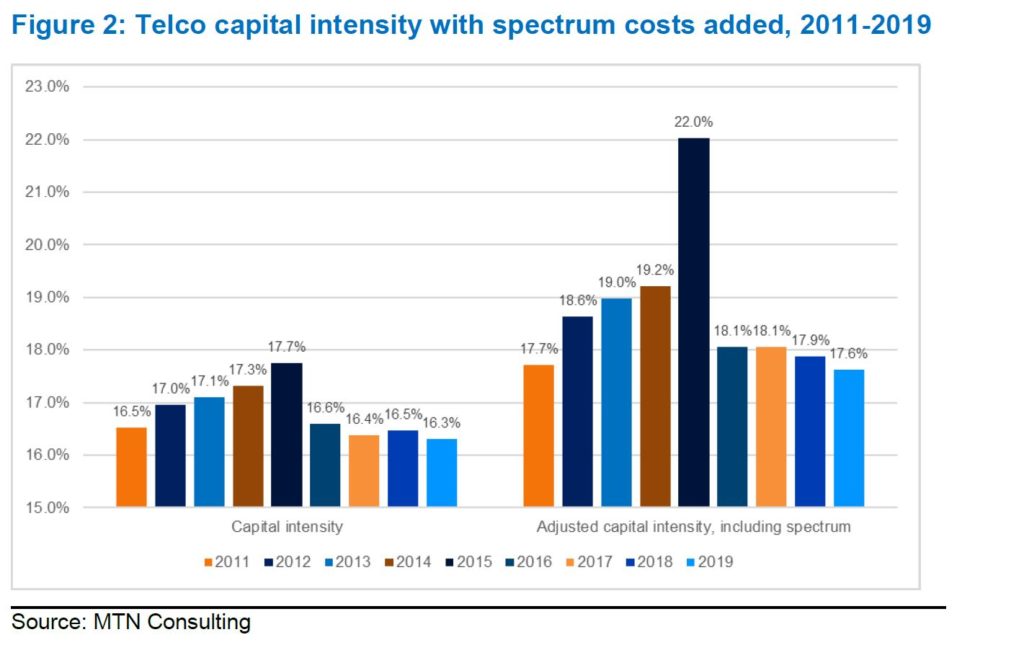By Matt Walker
Success of 5G relies heavily on affordable spectrum
Telecom operators are in the midst of an expensive network upgrade to support 5G mobile communications. Buying the spectrum — the radio frequencies reserved for use by the telecommunications industry — to support mobile service has proven costly over the last decade. With 5G’s arrival, spectrum costs threaten to overwhelm telcos already struggling with high core capital expenditures (capex) and a flat revenue outlook. Many spectrum auctions over the last year have delivered surprisingly high prices to telco buyers.
If telcos aspire to make money off 5G, now is the time to push for cheaper spectrum. Telcos need to lobby government bodies on auction terms; refarm, or repurpose older frequency bands so that they can be used for 5G; scour for available spectrum on the private market; and consider company acquisitions if the holdings are a match. The ongoing COVID-19 crisis will delay 5G deployments by at least three to six months, which creates some breathing room in which to address these issues.
Telcos also need to carefully study the technical means of delivering increased spectrum efficiency in the network. That includes, for instance, dynamic spectrum sharing, which Ericsson points to as a “key part of mobile service providers’ 5G strategy.” Relatedly, as MTN Consulting has argued elsewhere, telcos should consider ramping up their R&D budgets in order to independently assess the adoption of open radio access network/open networking solutions in the 5G network.
There are a number of common spectrum-related challenges facing operators across markets. That is verified by short case studies of 5G rollouts in the United Arab Emirates, Saudi Arabia, South Africa, Thailand, and Indonesia. For countries to see successful, affordable 5G deployments from multiple operators, policymakers need to do the following: shut down 2G and 3G networks to improve spectral efficiency; develop national spectrum roadmaps; facilitate low-cost device options; encourage development of new vertical markets in the Internet of Things; ensure operators can refarm unused spectrum; and address interference.
- Table Of Contents
- Figure & Charts
- Coverage
- Visuals
Table Of Contents
- Summary – page 3
- Success of 5G relies heavily on affordable spectrum
- About this report
- What’s the current situation? – page 4
- Telcos need to build 5G on the cheap given macro and industry realities
- Key findings
- How did we get here? – page 9
- The role of spectrum in wireless networks
- The role of spectrum in 5G deployments
- What happens next? – page 17
- Predictions
- Appendix – page 18
- About MTN Consulting
- Terms of Use
Figure & Charts
Figures & Charts
Figure 1: Telco Capex plus Spectrum (U.S.$B)
Figure 2: Telco capital intensity with spectrum costs added, 2011-2019
Figure 3: Spectrum cost added to core capex by company, 2011-2019 average
Figure 4: AT&T vs. Microsoft capital intensity
Figure 5: Select results of C-band auctions held in 2019-2020 (U.S.$M per MHz per person)
Figure 6: Supporting an end-to-end 5G experience
Figure 7: Range of frequencies in wireless communications
Figure 8: Use of radio waves in cellular networks
Figure 9: Telecom stats for case study examples
Coverage
Organizations mentioned in this report include:
AIS
Amazon Web Services
America Movil
AT&T
Axiata
BCE
Bharti Airtel
CAT
Cell C
China Mobile
China Telecom
China Unicom
Chunghwa Telecom
Cisco
CK Hutch
Dish Network Corporation
DT
DTAC
du
Ericsson
Etisalat
Frontier Communications
Huawei
Hutchison 3 Indonesia
IBM
Indosat Ooredoo
International Monetary Fund
International Telecommunication Union
Lebara
LG
Ligado Networks/Lightsquared
Megafon
Microsoft Azure
Mobily
MTN Group
Nokia
Ofcom
OneWeb
Orange SA
QCT
Rain
SAP
Singtel
SK Telecom
Smartfren
Softbank
STC
Telecom Italia
Telefonica
Telenor
Telkom Indonesia/Telkomsel
Telkom South Africa
Telus
TOT
TRAI
TrueMove H
TSMC
US Federal Communications Commission
Veon
Verizon
Virgin Mobile
VMWare
Vodacom
Vodafone
Wiwynn
XL Axiata
Zain Saudi Arabia
ZTE
Visuals


